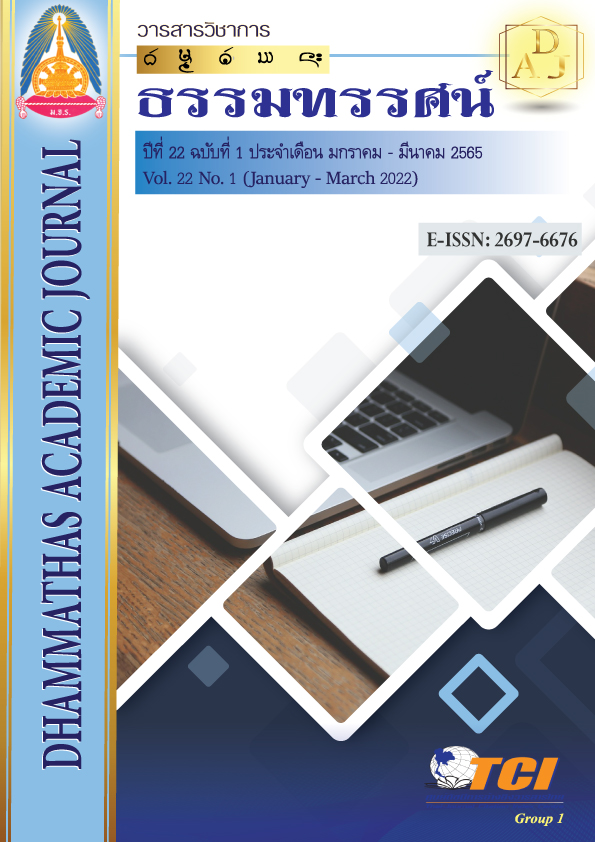How Thai Students Perceive BYOD as an Effective Strategy Applied in English Learning Environment
Main Article Content
Abstract
The objectives of this study were to 1) investigate the purposes for which BYOD is being used by the Thai undergraduate students in learning English classes, 2) explore the level of students’ satisfaction regarding the BYOD applied in learning English classes, and 3) examine the impacts of BYOD on students’ learning English. The study was designed as mixed-method research. The samples of this study were 50students, selected by applying random sampling technique. They were undergraduate students studying English as a university required subject. The opened-ended questionnaire, validated by the experts through the IOC, regarding their satisfaction toward their learning through their own devices has been employed as a research tool for collecting the data which were, then, asked to be completed by the students after they have been asked to practice their English skills by typically interacting with the English contents in the BYOD classroom context, applying their own technology devices into the classroom such as mobile phones, laptops, and tablets during the semester at the end of the semester.The data were then both statistically analyzed quantitatively shown in percentages, and qualitatively shown through descriptive analysis.
The findings showed that:
1. The purpose of applying BYOD of students for entertainment was ranked the highest at 80% followed by communication, collaboration in group work, access course materials, and research which was ranked the lowest at 52%.
2. 42% of the students were satisfied with the teaching and learning approach at the level of fully satisfaction.
3. The results unveiled that the implementing BYOD in the classroom had impacts on students learning in different ways, namely improving professional competence, inspiring learning, and critical thinking, increasing dependency on technology devices, and decreasing conventional document use.
Article Details

This work is licensed under a Creative Commons Attribution-NonCommercial-NoDerivatives 4.0 International License.
เพื่อให้เป็นไปตามกฎหมายลิขสิทธิ์ ผู้นิพนธ์ทุกท่านต้องลงลายมือชื่อในแบบฟอร์มใบมอบลิขสิทธิ์บทความ ให้แก่วารสารฯ พร้อมกับบทความต้นฉบับที่ได้แก้ไขครั้งสุดท้าย นอกจากนี้ ผู้นิพนธ์ทุกท่านต้องยืนยันว่าบทความ ต้นฉบับที่ส่งมาตีพิมพ์นั้น ได้ส่งมาตีพิมพ์เฉพาะในวารสาร วิชาการธรรม ทรรศน์ เพียงแห่งเดียวเท่านั้น หากมีการใช้ ภาพหรือตารางของผู้นิพนธ์อื่นที่ปรากฏในสิ่งตีพิมพ์อื่นมาแล้ว ผู้นิพนธ์ต้องขออนุญาตเจ้าของลิขสิทธิ์ก่อน พร้อมทั้ง แสดงหนังสือที่ได้รับการยินยอมต่อบรรณาธิการ ก่อนที่บทความจะได้รับการตีพิมพ์References
JAl-Okaily, R. (2015). Mobile Learning BYOD Implementation in an Intensive English Program. International Handbook of E-Learning Volume 2: Implementation and Case Studies, 311.
Beach, R. (2012). Uses of digital tools and literacies in the English Language Arts classroom. Research in the Schools, 19(1), 45-59.
Fallows, N. (2013). A Flipped Approach to Vocabulary Teaching in HCT Dubai Colleges Foundations Level 03: Utilising Spaced Repetition for Consolidation.
Felix, J. P. (2008). Edu blogging: Instruction for the digital age learner. Talking Points, 19(2), 14-21.
Fulton, K. (2012). Upside down and inside out: Flip Your Classroom to Improve Student Learning. Learning & Leading with Technology, 39(8), 12-17.
Grussendorf, S. (2013). Device ownership, 'BYOD' & social media for learning.
Hamza, A., & Nurdeen, M. F. (2013). BYOD Usage by Postgraduate Students of International Islamic University Malaysia: An Analysis. International Journal of Engineering Science Invention, 2(4), 14-20.
Handal, B., Ritter, R., & Marcovitz, D. (2014). Implementing large scale mobile learning school programs: To BYOD or not to BYOD. In EdMedia+ Innovate Learning (pp. 796-801). Association for the Advancement of Computing in Education (AACE).
Kuteeva, M. (2010). Wikis and academic writing: Changing the writer–reader relationship. English for Specific Purposes, 30(1), 44-57.
Parsons, D. (2013). Jam Today–Embedding BYOD into Classroom Practice. Science Proceedings, (12th World Conference on Mobile and Contextual Learning [mLearn 2013), 25.
Silvernail, D. L., & Gritter, A. K. (2007). Maine’s middle school laptop program: Creating better writers. Portland, ME: Center for Education Policy, Applied Research, and Evaluation, University of Southern Maine. Retrieved from http://www.usm.maine.edu/cepare/
Smith, M. M., Worrell-Burrus, P., Davis, M. K., Newman, M. J., & William, K. (2015). Are We Ready for BYOD?. Effective Schools Project, 16.
Vasant, S., & Mehta, B. (2015). A Case Study: Embedding ICT for Effective Classroom Teaching & Learning. In Emerging ICT for Bridging the Future-Proceedings of the 49th Annual Convention of the Computer Society of India (CSI) Volume 1 (pp. 541-547). Springer International Publishing.

